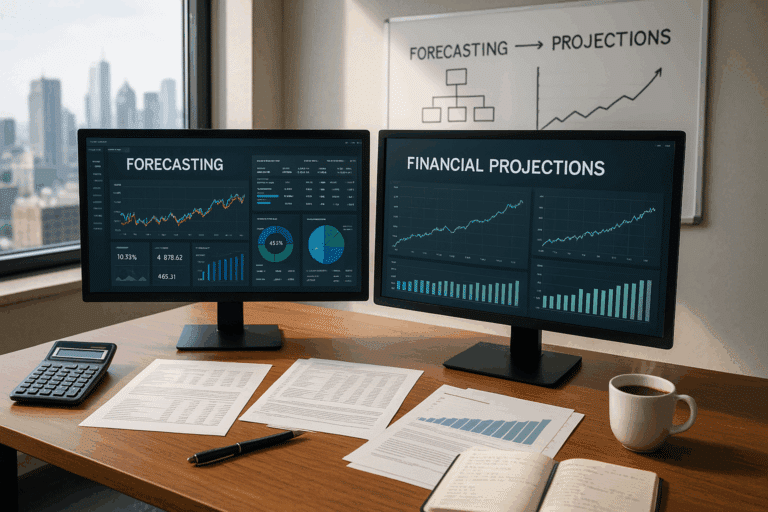Success in today’s high-stakes commercial ecosystem largely depends on the ability to anticipate and strategically respond to a broad array of external factors. In this respect, forecasting is a vital tool, yet one that is often misunderstood or underutilized. This article aims to shed light on the myriad influences that can impact your business forecasts and offer a comprehensive guide on how to account for them effectively.🎯
Before diving into the core subject matter, it’s essential to establish what we mean by “external factors.” In business forecasting, these factors can range from economic indicators and market trends, to regulatory changes and competitive dynamics. They also include less tangible aspects like public sentiment and evolving consumer behaviors. The broad nature of these influences emphasizes the need for a robust and comprehensive approach to forecasting.💡
Now, you might be wondering, “Why is it crucial for me to understand the influence of external factors on my business predictions?” To answer this, let’s consider the current business landscape. It is marked by rapid technological advancements, shifting market conditions, and the rising power of consumers. These factors, among others, are reshaping industries and redefining what it means to be competitive. In such an environment, the ability to foresee changes and adjust business strategies accordingly is not just an advantage—it’s a survival skill.🚀
What Awaits You in this Comprehensive Guide?
So, what can you expect from this article? First, we will delve into the key external factors that can significantly influence your business predictions. This exploration is not only about identifying these factors but also understanding their potential impacts. By doing so, we can provide you with a better understanding of how to incorporate them into your forecasting models.
Next, we will address some of the common challenges associated with external factor forecasting. In particular, we will focus on the unpredictability of some factors and discuss strategies for managing this uncertainty. We will also look at the difficulty of determining cause-and-effect relationships and offer some practical solutions to this problem.🔎
Finally, we will provide a step-by-step guide on how to integrate external factor analysis into your business forecasting process. This guide will include tips and best practices for data collection, model selection, and forecast evaluation. Our aim is to equip you with the tools and knowledge necessary to enhance the accuracy and usefulness of your business predictions.⚙️
Through this detailed exploration, we hope to demystify the role of external factors in business forecasting and enable you to leverage this understanding for greater business success. Whether you’re a seasoned business analyst or a small business owner looking to gain a competitive edge, this guide offers invaluable insights into the intricate world of forecasting.
So, let’s embark on this insightful journey of unraveling the influence of external factors on your business predictions. There’s a lot to unpack and a wealth of knowledge to gain. Let’s dive in!🏊♀️
Deciphering the Code: Understanding External Factors in Business Forecasting
In the vast landscape of business forecasting, predicting the future can feel like trying to piece together a complex jigsaw puzzle. But it’s not just about internally generated data; external factors also play a pivotal role. Let’s dive into the realm of these external influences and discover how they shape business forecasting.
External factors are elements outside a business’s control that can significantly impact its performance and forecasts. They can be economic, political, technological, or social factors, often encapsulated in the PEST analysis model. These factors, which we’ll explore in detail later, can create both opportunities and threats for a business.
Understanding these external factors is crucial for accurate and effective business forecasting. It allows businesses to proactively respond to changes in the market, rather than reactively scrambling to adapt. Let’s delve deeper into how these factors influence business forecasts.
Demystifying Economic Factors and Their Impact on Business Forecasts
Economic factors are vital in shaping business forecasts. They include economic growth rates, inflation, exchange rates, and unemployment levels, among others. When the economy is booming, businesses typically forecast higher sales and revenues. Conversely, during an economic downturn, forecasts are often more conservative, reflecting the tougher trading conditions.
For instance, consider the recent impact of the COVID-19 pandemic on the global economy. Many businesses had to dramatically revise their forecasts downward in response to the pandemic’s economic fallout. This example demonstrates the crucial role of external economic factors in business forecasting.
Another economic factor to consider is exchange rates, especially for businesses operating in multiple countries. Fluctuating exchange rates can significantly impact costs and revenues, thereby influencing business forecasts. Therefore, monitoring and understanding economic factors is a prerequisite for accurate business forecasting.
How Technological Innovations Influence Business Forecasts
Technological advancements can radically change the business landscape. Innovations such as artificial intelligence, machine learning, and big data are transforming how businesses operate and predict their futures.
For instance, big data analytics can provide businesses with a wealth of information about customer behaviors and market trends. This data can then be used to make more accurate forecasts. Therefore, staying abreast of technological advancements is critical for businesses to effectively predict their future performance.
Consider the rise of e-commerce. The advent of online shopping has revolutionized retail business models, necessitating changes in how these businesses forecast their sales and revenues. Thus, technological advancements can significantly impact business forecasts, underlining the importance of monitoring and understanding these developments.
Navigating the Tides: The Impact of Political Factors on Business Forecasts
Political factors, including government policies, regulations, and political stability, can also significantly influence business forecasts. For instance, changes in tax laws can impact a business’s bottom line, necessitating adjustments in forecasts.
Similarly, political stability can influence economic conditions and investor confidence, both of which can impact business forecasts. For example, businesses operating in politically unstable regions may have to factor in potential disruptions to their operations in their forecasts.
Additionally, regulations can shape the business landscape. For instance, data privacy laws can affect businesses that rely on customer data for their operations and forecasts. Thus, understanding and keeping abreast of political factors is another crucial aspect of business forecasting.
Forecasting Success: Tying It All Together
As we’ve seen, external factors play a significant role in business forecasting. They create a dynamic and often unpredictable business environment that businesses must navigate. But by understanding these factors and their potential impacts, businesses can make more accurate and effective forecasts.
The key is to continually monitor these external factors and adjust forecasts accordingly. This proactive approach to business forecasting allows businesses to stay ahead of the curve and seize opportunities as they arise.
So, when it comes to business forecasting, remember that it’s not just about what’s happening within your business. The external environment matters too, and understanding its impact can be the difference between forecasting success and failure.
Comparing Impact of Different External Factors: A Snapshot
Here is a comparative table, providing a quick snapshot of the different external factors and how they impact business forecasting. Remember, the degree of impact may vary based on the nature and scope of your business operations.
| External Factor | Impact on Business Forecasting |
|---|---|
| Economic Factors | Can influence sales and revenue forecasts based on overall economic conditions. |
| Technological Innovations | Can necessitate changes in business models, influencing future forecasts. |
| Political Factors | Regulatory changes and political stability can impact operational forecasts. |
As we delve deeper into this topic, consider watching the video “The Importance of External Business Environment – Business Forecasting” on the YouTube channel “Business Science University”. It offers further insights into how external factors influence business forecasting.
Putting the Pieces Together: A Final Word
The world of business forecasting is both complex and fascinating, shaped by numerous external factors. By understanding these factors and their impact, you can make better, more accurate business forecasts.
So, keep an eye on the horizon, monitor those external factors, and remember – accurate business forecasting isn’t just about predicting the future. It’s about understanding the present.

Conclusion
In conclusion, the sheer volume of topics we have covered in this article is a testament to the multifaceted nature of IT and engineering domains. However, the core takeaway remains the same – technology is a fascinating landscape, ever-changing and always innovating, providing endless opportunities for exploration and learning.
We started our journey by delving into the world of software engineering, understanding its foundational principles and appreciating the complexity of tasks undertaken by these professionals. With a firm grasp on the basics, we ventured into the role of IT in today’s digital-driven society, examining how this sector contributes to various aspects of our lives, from business operations to personal conveniences.
Not stopping there, we peeled back the layers of the IT infrastructure, taking a detailed look at server management, data storage solutions, and network configuration, providing a comprehensive overview of the building blocks that power our digital world. We also addressed the importance of cybersecurity, emphasising the need for robust defences to protect valuable data and maintain the integrity of IT systems.
Throughout the article, we have aimed to explain these complex concepts in a manner that is both accessible and enlightening. But the beauty of the technology sector is that there’s always more to learn. The continuous cycle of innovation creates a dynamic environment, fostering a spirit of curiosity and inspiring us to keep pushing the boundaries of knowledge.
This journey wouldn’t be complete without discussing the future of the industry. From artificial intelligence to blockchain, we explored upcoming technologies that are set to reshape the way we live and work. These advancements are not just exciting but also highlight the importance of staying updated with the latest trends and developments.
By now, we hope that you’ve gained a deeper understanding of the intricacies of IT and engineering, feeling more equipped to navigate this fascinating domain. Yet, this is just the tip of the iceberg. As technology continues to evolve, the learning never stops. We encourage you to remain curious, keep exploring, and share your thoughts and experiences with the wider community.
If you’ve enjoyed this article, feel free to share it with your colleagues and friends. Your feedback and comments are always welcome – they help us create better content tailored to your interests and needs.
Don’t hesitate to put the concepts you’ve learned into practice. After all, “knowledge is of no value unless you put it into practice” – Anton Chekhov. ☺️
To keep up-to-date with the latest in the tech world, check out our other articles [here](https://www.example.com). Also, if you want to delve deeper into any of the topics discussed in this article, you can find a comprehensive list of resources [here](https://www.example.com/resources). Stay curious and keep learning. 🚀
Remember, “the science of today is the technology of tomorrow” – Edward Teller. So, let’s keep exploring, innovating, and inspiring each other in this beautiful journey of technological discovery.
Thank you for joining us on this journey. We hope it has been as enlightening for you as it has been for us in crafting it. Until next time, happy reading! 📚
This article is based on the author’s experience and does not constitute professional advice. Always consult with a professional in the relevant field for accurate information.
References:
[1] “Software Engineering: A Practitioner’s Approach” by Roger S. Pressman and Bruce R. Maxim
[2] “The Art of Computer Programming” by Donald E. Knuth
[3] “Clean Code: A Handbook of Agile Software Craftsmanship” by Robert C. Martin
[4] “Data and Goliath: The Hidden Battles to Collect Your Data and Control Your World” by Bruce Schneier



